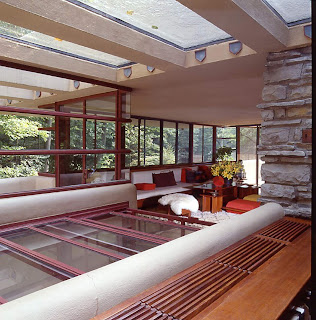 |
| Wright's roofs: "They don't call it Fallingwater for nothing." (Bear Run, Pennsylvania, completed 1939) |
The embarrassing fact is that leaky roofs are endemic to architecture, whether modern or traditional, and the caliber of the architect makes little difference. The occupants of Frank Lloyd Wright’s most celebrated houses have been obliged to drag out buckets, bowls, and soup cans in many a rainstorm. Or as a colleague of mine once put it: “They don’t call it ‘Fallingwater’ for nothing”.
For their part, architects are notoriously adept at brushing off the leak problem. Wright once received a call from an irate client who complained that the roof was leaking all over her dinner guest.
 |
| The architect Le Corbusier bears much of the responsibility for stoking the flat roof craze of the Modernist era. (Villa Savoye, Poissy, France, completed 1933) |
At least Wright fessed up to these shortcomings, however nonchalantly; the same can’t be said for the famed International Style architect Le Corbusier. Early in his career, he designed a building with a conventional pitched roof. At the first snowfall, it leaked like a sieve—due, it seems, to his own inexperience. In a classic piece of Modernist logic, however, Corbu concluded that the whole concept of pitched roofs must be flawed, and thereafter espoused flat roofs instead.
Ah, poor posterity!
 |
| If you're looking for countless leaks, this is the roof for you. Otherwise, heed the famous acronym KISS: Keep It Simple, Stupid |
• Keep the roof design as simple as possible. Leaks seldom occur out in the middle of a roof’s flat surfaces—or “field”, in roofing parlance. Rather, they tend to develop in the many nooks and crannies formed where roof planes intersect, or where roofs abut walls. Hence, the simpler the design, the fewer the intersections, and the less the likelihood of leaks. Be especially wary of those craggy alpine roofscape favored by current architectural fashion. All those cute little peaks and dormers can become a major leakage headache a few years down the road.
 |
| Frank Lloyd Wright: "If it didn't leak, it wouldn't be a roof." |
• Avoid built-up (“flat”) roofs whenever possible. Granted, built-up roofs are cheap, easy to construct, and great for covering oddly-shaped floor plans. However, without conscientious maintenance—which they seldom get—built-up roofs simply won’t stay watertight. A half-century of painful experience has borne this fact out, suggesting that our pitch-roof loving forebears were probably right after all.
Sorry, Le Corbusier.
No comments:
Post a Comment